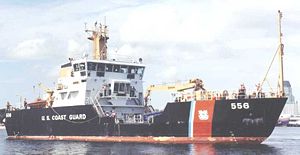Keeper-class cutter

USCG Coastal Buoy Tender Joshua Appleby WLM-556
|
|
| Class overview | |
|---|---|
| Built: | 1995–2000 |
| In commission: | 1996 to date |
| Completed: | 14 |
| General characteristics | |
| Displacement: | 840 long tons (850 t) |
| Length: | 175 ft (53.3 m) |
| Beam: | 36 ft (11.0 m) |
| Draft: | 7.9 ft (2.4 m) |
| Propulsion: |
|
| Speed: | 12 kn (22 km/h; 14 mph) |
| Complement: | 24 |
| Sensors and processing systems: |
Furuno SPS-50 navigation radar |
The United States Coast Guard commissioned a new Keeper class of coastal buoy tenders in the 1990s that are 175 feet (53 m) in length and named after lighthouse keepers.
Keeper-class cutters serve the Coast Guard in a variety of missions and are tasked with maintaining aids to navigation (ATON), search and rescue (SAR), law enforcement (LE), migrant interdiction, marine safety inspections, environmental protection and natural resources management. Keeper-class cutters are also used for light ice breaking operations.
These vessels are 175' long and replaced the World War II era 180', 157' and 133' tenders. The new class of buoy tender cut crew size from 50, 35 and 26, respectively, to 25 saving the already cash strapped Coast Guard financial and personnel resources.
Keeper-class cutters were built by Marinette Marine of Marinette WI.
Keeper-class cutters are equipped with mechanical Z-drive azimuth thruster propulsion units instead of the standard propeller and rudder configuration. These mechanical drives are designed to independently rotate 360 degrees. Combined with a thruster in the bow, they enable Keeper-class tenders to dynamically maneuver in a variety of sea states. This creates an extremely maneuverable platform which, when combined with modern navigation aids such as GPS, DPS, and ECDIS to allow the Cutter to maintain static positions. This allows the cutter to precisely place an aid to navigation (ATON).
Keeper-class boarding teams are armed with modern small arms.
The following 175-foot WLMs in Service (as of 2006):
...
Wikipedia
